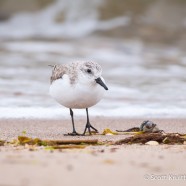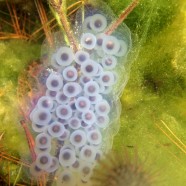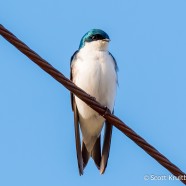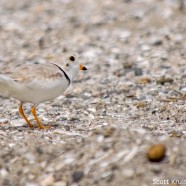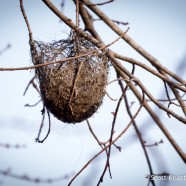Sanderling
Here we have a Sanderling (Calidris alba), a bird that spends its winter on our sandy beaches before heading to the High Arctic for the nesting season. They are often misidentified as Piping Plovers during migratory periods as both small, white shorebirds (in nonbreeding plumage for the Sanderling anyway) feed along the water like this. A rufous breeding plumage pattern takes over where the gray is, and by May these birds look unique and spectacular. So much change in so little time…and so much flight distance covered before they nest and head back to us later in the summer. If that...
Read MoreDo you know your amphibian egg masses?
Despite the snow, the internal clocks of many amphibians are already set to spring. As a result, a number of them have already journeyed from the safety of their winter refuges to nearby pools and ponds to breed and deposit their eggs. This past Friday, prior to the weekend storm, I spent time exploring some local water bodies and found a plethora of these kinds of eggs. Any idea of what these little eggs will eventually turn into? I’ll give you a hint, the bottom picture shows both eggs and spermatophores. If you guessed Spotted Salamander (Ambystoma maculatum), you would be correct!...
Read MoreTree Swallow
Happy Easter! This Tree Swallow is one of many returning individuals migrating north this March, heading back to your yard or patch for the spring nesting season. I thought I would show you this bird from last week instead of showing you some eggs from past years and remind everyone to clean out their boxes now! Birds will be pairing up and starting to build those nests next month. After a cool start to April the long-term forecasts for spring look very warm, and there will be plenty of bugs for these birds to eat. Don’t forget to help them out with the spring cleaning… Scott...
Read More2015 Waterbird Results
The Connecticut Department of Energy and Environmental Protection’s Wildlife Division (CT DEEP) has now released the official nesting results for the state-threatened Least Tern and the federally-threatened Piping Plover from the 2015 monitoring season, and the Audubon Alliance for Coastal Waterbirds (AAfCW) – Audubon Connecticut and the Roger Tory Peterson Institute of Natural History – has completed our American Oystercatcher report. The first bit of fantastic news is that we hosted a new all-time high number of Piping Plover pairs in the state with 62 attempting to breed...
Read MoreExposed Nest
The onset of winter always exposes other parts of nature that we may have missed earlier in the year. In this case this looks to possibly be a Baltimore Oriole nest on a tree near a pond. I visited this spot a few times during what would have been the breeding season, but I did not notice them way up there among the leaves. I wonder how successful they were and if all of their nestlings made it out into the world. Scott Kruitbosch Conservation & Outreach Coordinator
Read More



